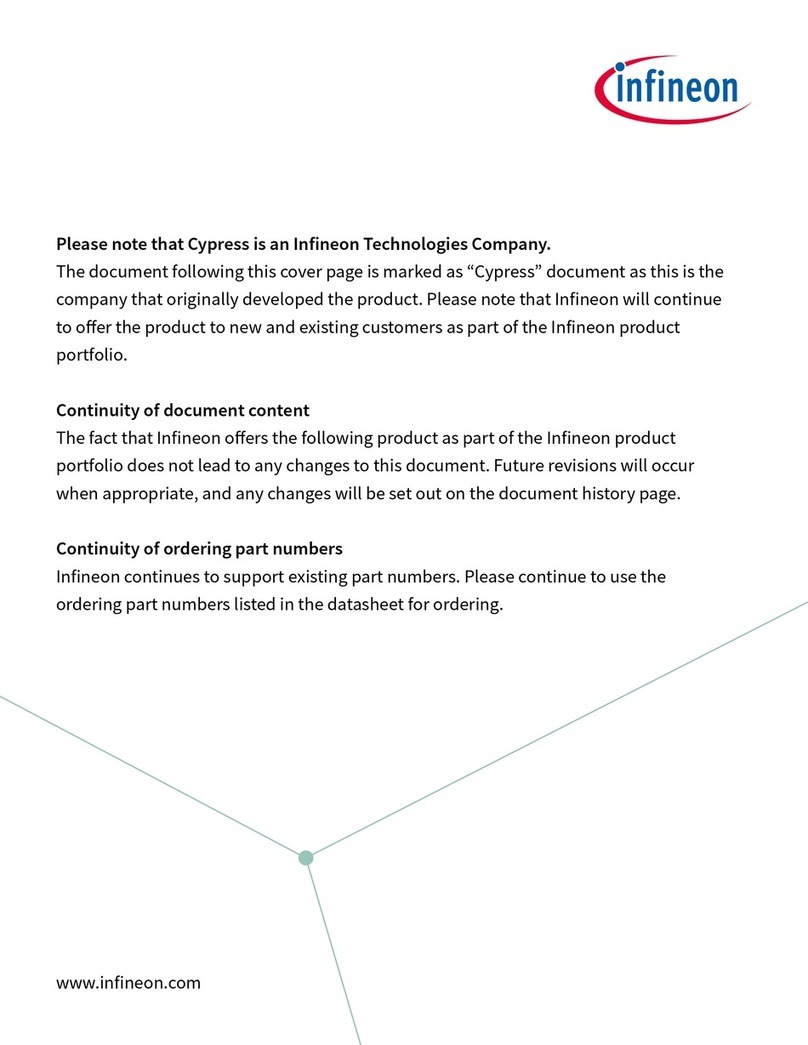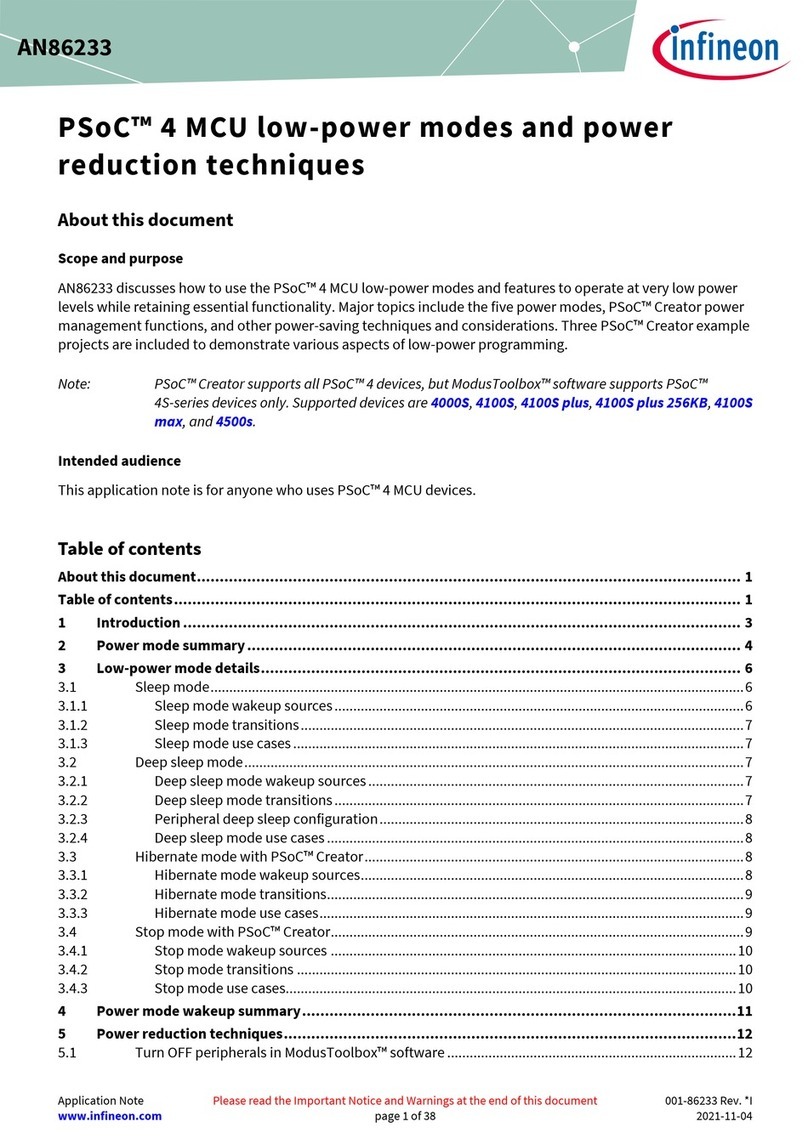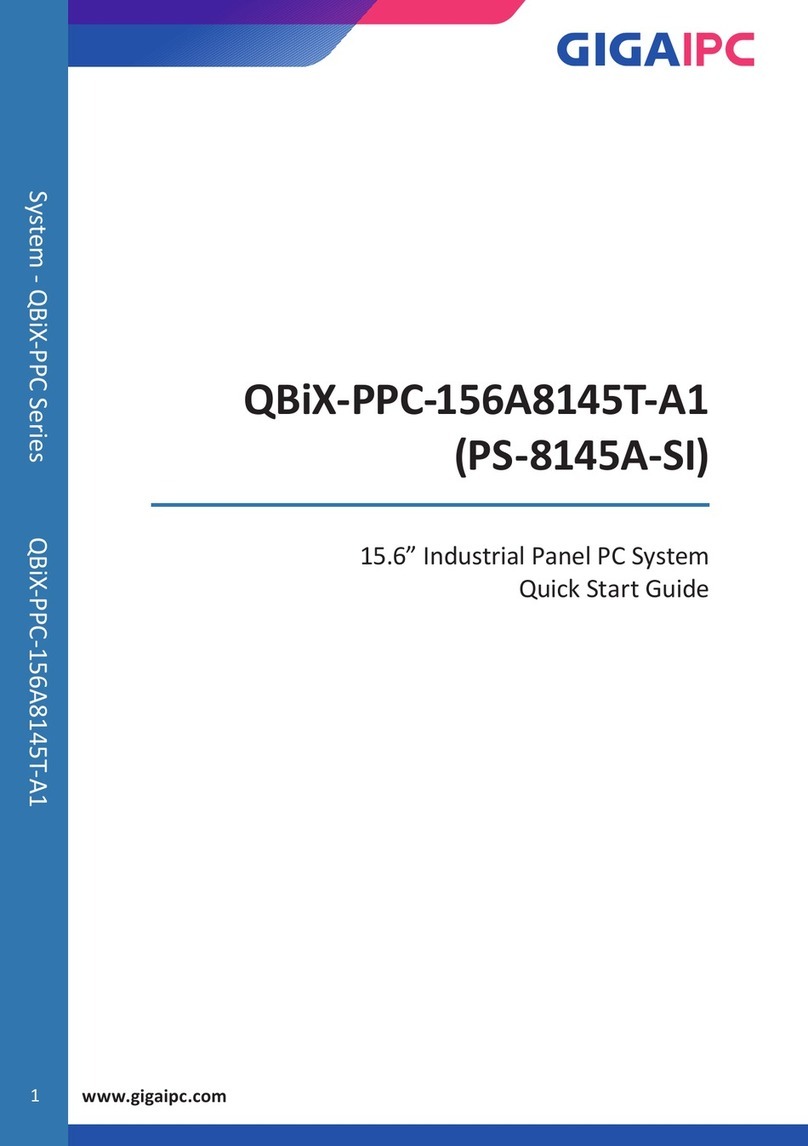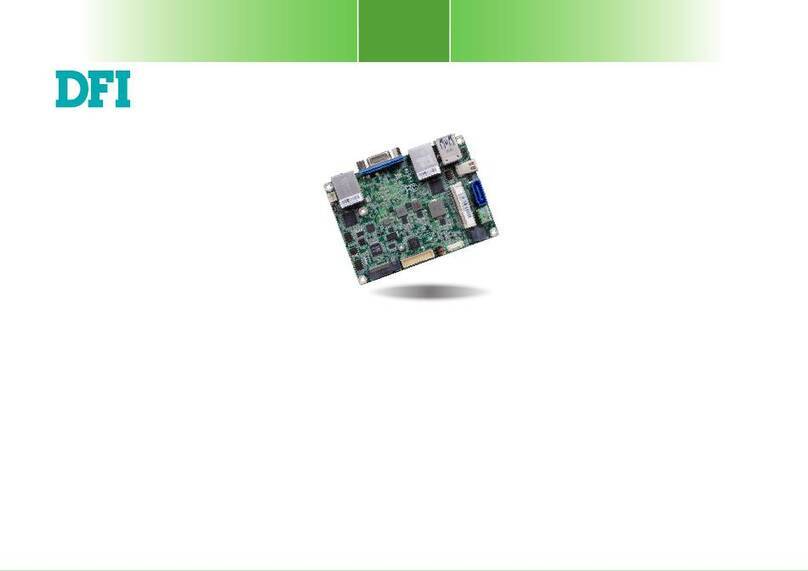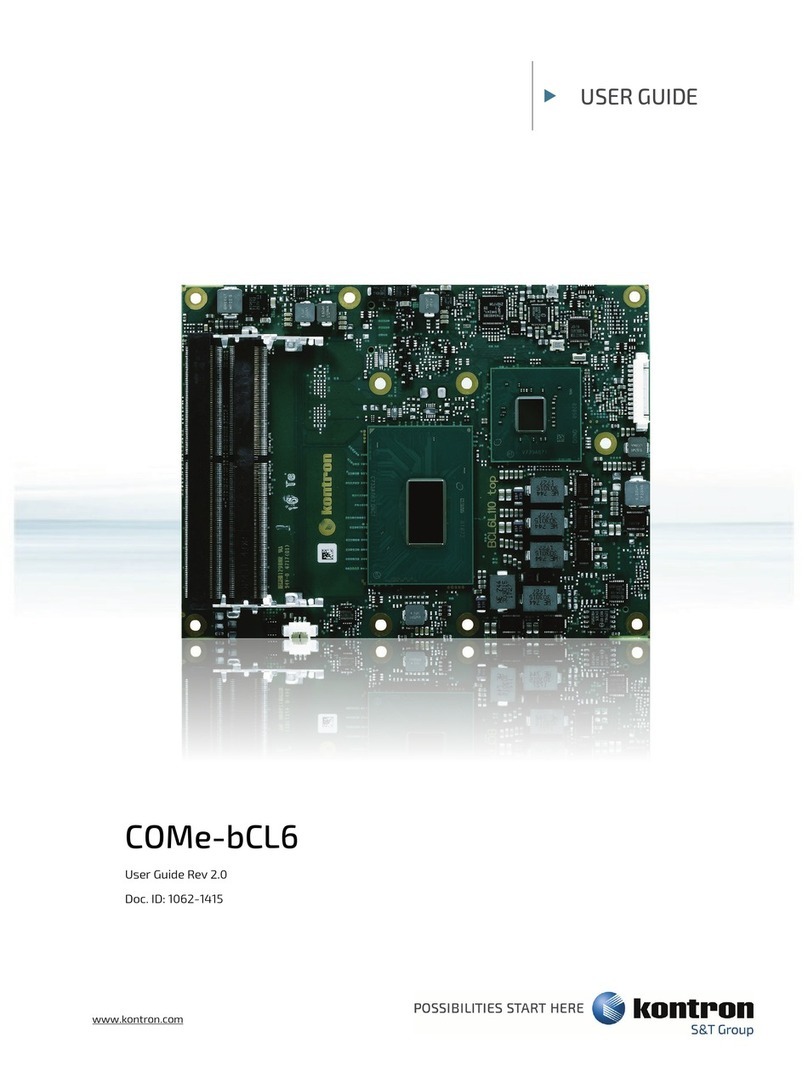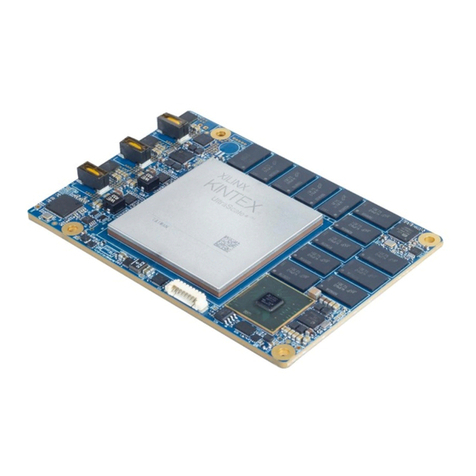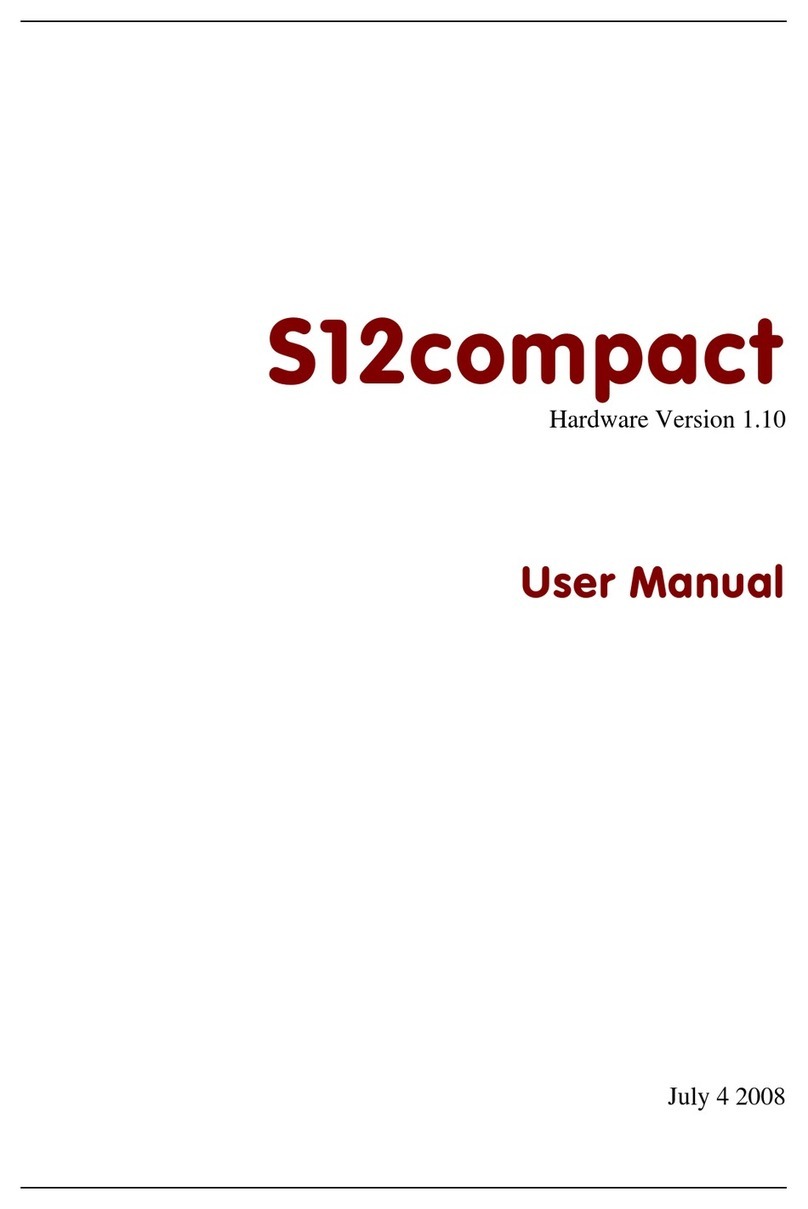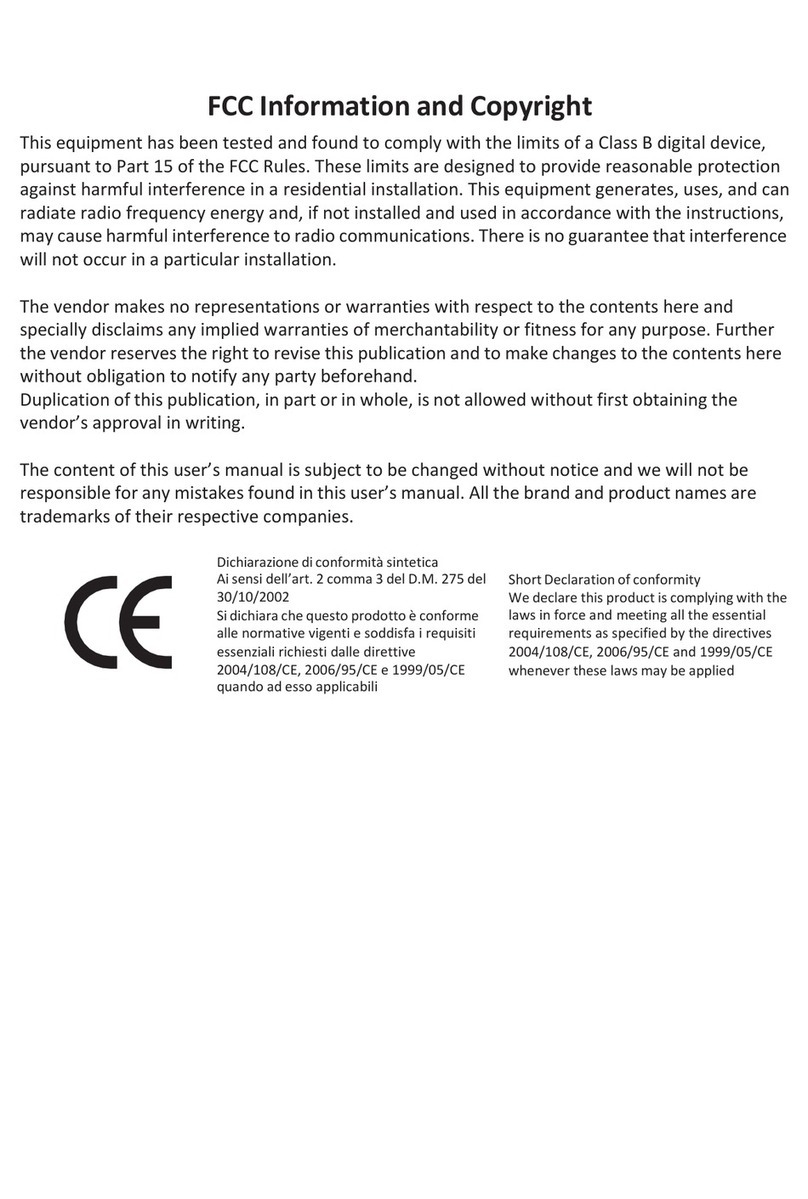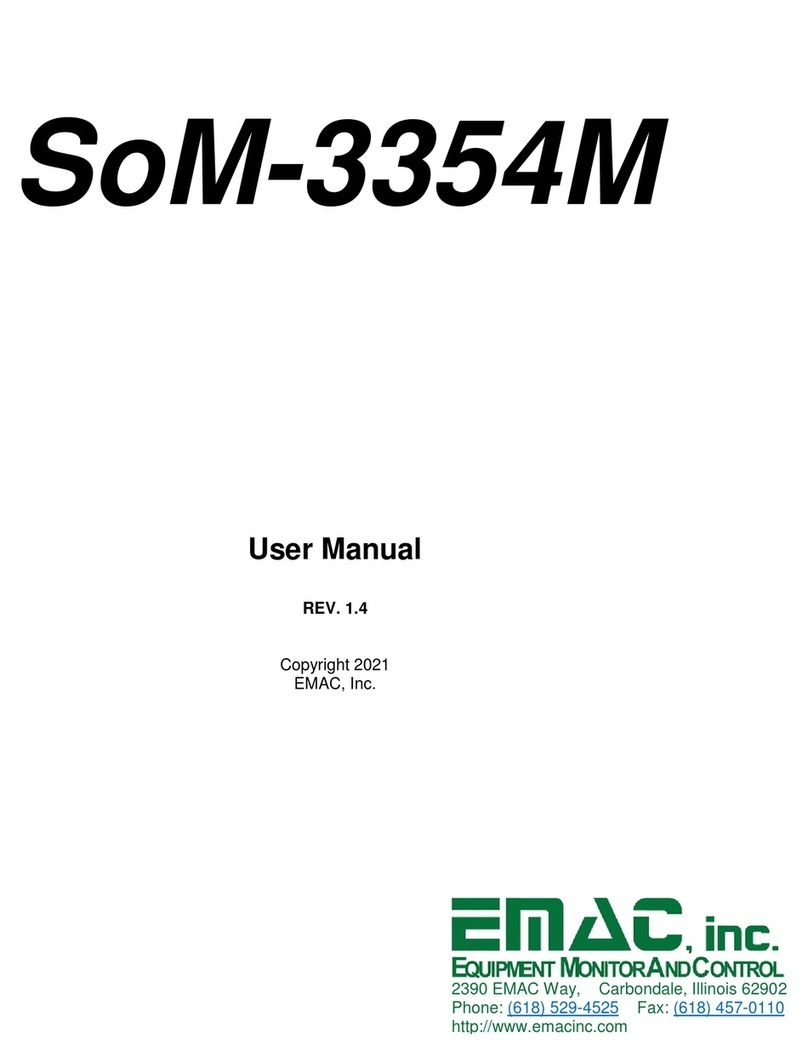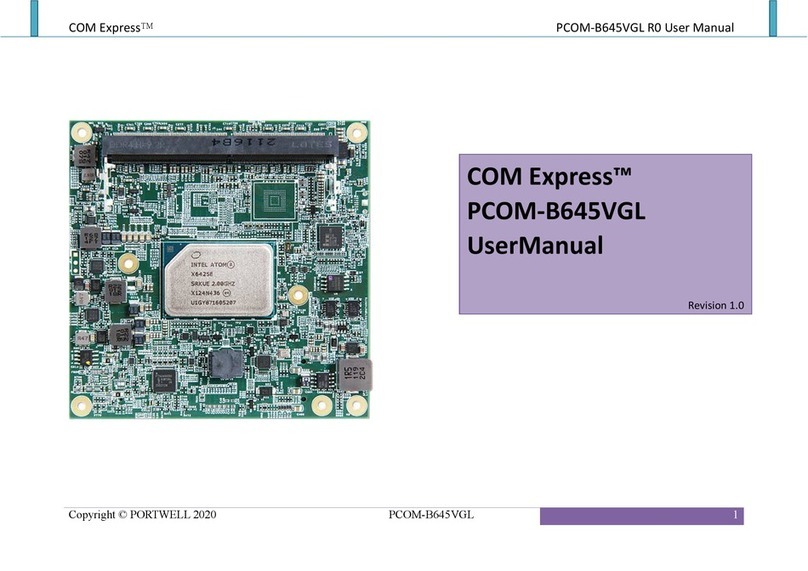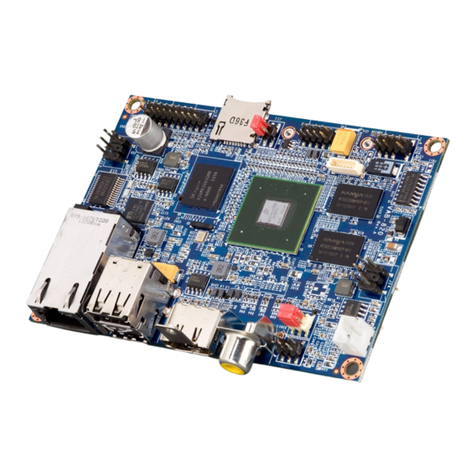Infineon Cypress WICED CYW43903 User manual

www.infineon.com
Please note that Cypress is an Infineon Technologies Company.
The document following this cover page is marked as “Cypress” document as this is the
company that originally developed the product. Please note that Infineon will continue
to oer the product to new and existing customers as part of the Infineon product
portfolio.
Continuity of document content
The fact that Infineon oers the following product as part of the Infineon product
portfolio does not lead to any changes to this document. Future revisions will occur
when appropriate, and any changes will be set out on the document history page.
Continuity of ordering part numbers
Infineon continues to support existing part numbers. Please continue to use the
ordering part numbers listed in the datasheet for ordering.

PRELIMINARY CYW43903
WICED™ IEEE 802.11 a/b/g/n SoC with an
Embedded Applications Processor
Cypress Semiconductor Corporation • 198 Champion Court • San Jose,CA 95134-1709 • 408-943-2600
Document Number: 002-14826 Rev. *G Revised January 11, 2018
The Cypress CYW43903 embedded wireless system-on-a-chip (SoC) is uniquely suited for Internet-of-Things applications. It sup-
ports all rates specified in the IEEE 802.11 b/g/n specifications.The device includes an ARM Cortex-based applications processor, a
single stream IEEE 802.11n MAC/baseband/radio, a power amplifier (PA), and a receive low-noise amplifier (LNA). It also supports
optional antenna diversity for improved RF performance in difficult environments.
The CYW43903 is an optimized SoC targeting embedded Internet-of-Things applications in the industrial and medical sensor, home
appliance markets. Using advanced design techniques and process technology to reduce active and idle power, the device is
designed for embedded applications that require minimal power consumption and a compact size.
The device includes a PMU for simplifying system power topology and allows for direct operation from a battery while maximizing
battery life.
Cypress Part Numbering Scheme
Cypress is converting the acquired IoT part numbers from Broadcom to the Cypress part numbering scheme. Due to this conversion,
there is no change in form, fit, or function as a result of offering the device with Cypress part number marking. The Table 1 provides
Cypress ordering part number that matches an existing IoT part number.
Table 1. Mapping Table for Part Number between Broadcom and Cypress
Features
Application Processor Features
■ARM Cortex-R4 32-bit RISC processor.
■1 MB of on-chip SRAM for code and data.
■An on-chip cryptography core
■640 KB of ROM containing WICED SDK components such
as RTOS and TCP/IP stack.
■17 GPIOs supported.
■Q-SPI serial flash interface to support up to 40 Mbps of peak
transfer.
■Support for UART (3), SPI or CSC master, interfaces.
(Cypress Serial Control (CSC) is an I2C-compatible inter-
face.)
Key IEEE 801.11x Features
■Single-band 2.4 GHz IEEE 802.11n compliant.
■Single-stream spatial multiplexing up to 72 Mbps.
■Supports 20 MHz channels with optional SGI.
■Full IEEE 802.11 b/g legacy compatibility with enhanced per-
formance.
■TX and RX low-density parity check (LDPC) support for
improved range and power efficiency.
■On-chip power and low-noise amplifiers.
■An internal fractional nPLL allows support for a wide range of
reference clock frequencies.
■Integrated ARM Cortex-R4 processor with tightly coupled
memory for complete WLAN subsystem functionality, mini-
mizing the need to wake up the applications processor for
standard WLAN functions (to further minimize power con-
sumption while maintaining the ability to upgrade to future
features in the field).
■Software architecture supported by standard WICED SDK
allows easy migration from existing discrete MCU designs
and to future devices.
■Security support:
❐WPA and WPA2 (Personal) support for powerful encryp-
tion and authentication.
❐AES and TKIP in hardware for faster data encryption and
IEEE 802.11i compatibility.
❐Reference WLAN subsystem provides Cisco Compatible
Extensions (CCX, CCX 2.0, CCX 3.0, CCX 4.0, and CCX
5.0).
❐Wi-Fi Protected Setup and Wi-Fi Easy-Setup
■Worldwide regulatory support: Global products supported
with worldwide design approval.
Broadcom Part Number Cypress Part Number
BCM43903 CYW43903
BCM43903KUBG CYW43903KUBG

Document Number: 002-14826 Rev. *G Page 2 of 65
PRELIMINARY CYW43903
General Features
■Supports battery voltage range from 3.0V to 4.8V with an
internal switching regulator.
■Programmable dynamic power management.
■6 Kb OTP memory for storing board parameters.
■151-ball WLBGA (4.91mm x 5.85mm, 0.4 mm pitch).
Figure 1. Functional Block Diagram
CYW43903
APPS Domain WLAN
Always-On Domain
UART
DMA
32 KB (I),
32 KB (D)
ICACHE
AXI to AXI
Bridge
Crytography
Engine
APPS ARM
Cortex-R4
1 MB RAM,
640 KB ROM
SPI
PWM (6)
CSC
GPIO (17)
32 kHz
External LPO
PS RAM
PS
SR_Eng
PMU
Control
PMU
AXI-to-AXI
Bridge
AXI
VIO
REG_ON
HIB_REG_ON_IN AXI
IEEE 802.11 MAC
1 x 1, IEEE 802.11n PHY
2.4 GHz Radio
LNA 2.4GHz
AXI-to-AXI
Bridge
WLAN
ARM
Cortex-R4
TCM
512 KB RAM
320 KB ROM
AXI
PA
RF Switch Controls
37.4 MHz Crystal
CSC=CypressSerialControl.AnI2C‐compatibleinterface.
SPI or CSC
TX
Switch
TX
Switch
WRF_RFIN_2G
WRF_PAOUT_2G
CSC
PWM
SPI
GPIO
JTAG
VBAT

Document Number: 002-14826 Rev. *G Page 3 of 65
PRELIMINARY CYW43903
Contents
1. Overview ............................................................ 5
1.1 Introduction ......................................................... 5
1.1.1 Features ..................................................6
1.2 Standards Compliance ........................................7
2. Power Supplies and Power Management ....... 8
2.1 Power Supply Topology ...................................... 8
2.2 CYW43903 Power Management Unit Features .. 8
2.3 Power Management .......................................... 11
2.4 PMU Sequencing ..............................................11
2.5 Power-Off Shutdown ......................................... 12
2.6 Power-Up/Power-Down/Reset Circuits ............. 12
3. Frequency References ................................... 13
3.1 Crystal Interface and Clock Generation ............ 13
3.2 External Frequency Reference ......................... 14
3.3 External 32.768 kHz Low-Power Oscillator ....... 15
4. Applications Subsystem ................................ 16
4.1 Overview ........................................................... 16
4.2 Applications CPU and Memory Subsystem ...... 16
4.3 Memory-to-Memory DMA Core ......................... 16
4.4 Cryptography Core ............................................ 16
5. Applications Subsystem External Interfaces 17
5.1 GPIO ................................................................. 17
5.2 Cypress Serial Control ......................................17
5.3 JTAG and ARM Serial Wire Debug ................... 17
5.4 PWM ................................................................. 18
5.5 SPI Flash ........................................................... 18
5.6 UART ................................................................ 18
5.7 SPI .................................................................... 19
6. Global Functions............................................. 20
6.1 External Coexistence Interface ......................... 20
6.2 One-Time Programmable Memory .................... 20
6.3 Hibernation Block .............................................. 20
6.4 System Boot Sequence ..................................... 21
7. Wireless LAN Subsystem............................... 22
7.1 WLAN CPU and Memory Subsystem ............... 22
7.2 IEEE 802.11n MAC ........................................... 22
7.2.1 PSM .......................................................23
7.2.2 WEP ...................................................... 23
7.2.3 TXE ........................................................ 23
7.2.4 RXE .......................................................24
7.2.5 IFS ......................................................... 24
7.2.6 TSF ........................................................ 24
7.2.7 NAV .......................................................24
7.2.8 MAC-PHY Interface ................................24
7.3 IEEE 802.11™ b/g/n PHY ...................................25
8. WLAN Radio Subsystem ............................... 26
8.1 Receiver Path .....................................................26
8.2 Transmit Path .....................................................26
8.3 Calibration ..........................................................26
9. Pinout and Signal Descriptions..................... 27
9.1 Ball Map .............................................................27
9.2 Ball List ...............................................................28
9.3 Signal Descriptions ............................................30
10.GPIO Signals and Strapping Options ........... 34
10.1 Overview ............................................................34
10.2 Weak Pull-Down and Pull-Up Resistances ........34
10.3 Strapping Options ..............................................34
10.4 Alternate GPIO Signal Functions .......................35
11.Pin Multiplexing .............................................. 36
12.I/O States ......................................................... 38
13.Electrical Characteristics............................... 40
13.1 Absolute Maximum Ratings ...............................40
13.2 Environmental Ratings .......................................41
13.3 Electrostatic Discharge Specifications ...............41
13.4 Recommended Operating Conditions and DC
Characteristics ...................................................41
13.5 Power Supply Segments ....................................43
13.6 GPIO, UART, and JTAG Interfaces DC
Characteristics ...................................................43
14.WLAN RF Specifications ................................ 44
14.1 Introduction ........................................................44
14.2 2.4 GHz Band General RF Specifications ..........44
14.3 WLAN 2.4 GHz Receiver Performance
Specifications .....................................................45
14.4 WLAN 2.4 GHz Transmitter Performance
Specifications .....................................................47
14.5 General Spurious Emissions Specifications .......48
14.5.1 Transmitter Spurious Emissions
Specifications .........................................48
14.5.2 Receiver Spurious Emissions
Specifications .........................................48
15.Internal Regulator Electrical Specifications. 49
15.1 Core Buck Switching Regulator .........................49
15.2 3.3V LDO (LDO3P3) ..........................................50
15.3 CLDO .................................................................51
15.4 LNLDO ...............................................................52

Document Number: 002-14826 Rev. *G Page 4 of 65
PRELIMINARY CYW43903
15.5 BBPLL LDO ....................................................... 53
16.System Power Consumption ......................... 54
16.1 WLAN Current Consumption ............................. 54
16.1.1 2.4 GHz Mode ....................................... 54
17.SPI Flash Characteristics............................... 55
17.1 SPI Flash Timing ............................................... 55
17.1.1 Read-Register Timing ............................ 55
17.1.2 Write-Register Timing ............................ 56
17.1.3 Memory Fast-Read Timing .................... 57
17.1.4 Memory-Write Timing ............................ 58
17.1.5 SPI Flash Parameters ........................... 59
18.Power-Up Sequence and Timing ................... 60
18.1 Sequencing of Reset and Regulator Control
Signals .............................................................. 60
18.1.1 Description of Control Signals ............... 60
18.1.2 Control Signal Timing Diagrams ............ 60
19.Thermal Information ....................................... 61
19.1 Package Thermal Characteristics ......................61
19.2 Junction Temperature Estimation and PSIJT
Versus THETAJC .............................................................61
19.3 Environmental Characteristics ...........................61
20.Mechanical Information.................................. 62
21.Ordering Information...................................... 63
22.Additional Information ................................... 63
22.1 Acronyms and Abbreviations .............................63
22.2 IoT Resources ....................................................63
22.3 Errata .................................................................63
Document History Page ................................................. 64
Sales, Solutions, and Legal Information ...................... 65

Document Number: 002-14826 Rev. *G Page 5 of 65
PRELIMINARY CYW43903
1. Overview
1.1 Introduction
The Cypress CYW43903 is a single-chip device that provides the highest level of integration for an embedded system-on-a-chip with
integrated IEEE 802.11 b/g/n MAC/baseband/radio and a separate ARM Cortex-R4 applications processor. It provides a small form-
factor solution with minimal external components to drive down cost for mass volumes and allows for an embedded system with
flexibility in size, form, and function. Comprehensive power management circuitry and software ensure that the system can meet the
needs of highly embedded systems that require minimal power consumption and reliable operation.
Figure 2 shows the interconnect of all the major physical blocks in the CYW43903 and their associated external interfaces, which are
described in greater detail in Applications Subsystem External Interfaces.
Figure 2. Block Diagram and I/O
Note: Another SPI interface can be defined by reconfiguring GPIO_8 through GPIO_11 and another CSC interface can be defined
by reconfiguring GPIO_12 and GPIO_13 (see Table 11, “Pin Multiplexing,”).
APPS Subsystem WLAN Subsystem
CYW43903
SPI Flash
GPIO[16:0]
2x 2-Wire UART
4-Wire UART
SPI/CSC
CSC
JTAG/SWD
WAKE
RF TX
RF RX
Switch Control
Antenna Diversity
VDDIOs
GND
ARMCortex‐R4
160MHz
32KBI‐cache
32KBD‐cache
1MBSRAM
640KBROM
ARMCortex‐R4
160MHz
448KBROMTCM
576KBSRAMTCM
802.11n
1x1
2.4GHz

Document Number: 002-14826 Rev. *G Page 6 of 65
PRELIMINARY CYW43903
1.1.1 Features
The CYW43903 supports the following features:
■ARM Cortex-R4 clocked at 160 MHz.
■1 MB of SRAM and 640 KB ROM available for the applications processor.
■One high-speed 4-wire UART interface with operation up to 4 Mbps.
■Two low-speed 2-wire UART interfaces multiplexed on general purpose I/O (GPIO) pins.
■One dedicated CSC1 interface.
Note: Another CSC interface can be defined by reconfiguring GPIOs. See Table 11, “Pin Multiplexing,”.
■One SPI master interface with operation up to 24 MHz.
Either or both of the SPI interfaces can be used as CSC master interfaces. This is in addition to the two dedicated CSC interfaces.
Note: In addition to the dedicated CSC interface, the SPI interface can be used as a CSC master interface.
Note: Another SPI interface can be defined by reconfiguring GPIOs. See Table 11, “Pin Multiplexing,”.
■One SPI master interface for serial flash.
■Six dedicated PWM outputs.
■17 GPIOs.
■IEEE 802.11 b/g/n 1×1 2.4 GHz radio.
■Single- and dual-antenna support.
1.Cypress Serial Control (CSC) is an I2C-compatible interface.

Document Number: 002-14826 Rev. *G Page 7 of 65
PRELIMINARY CYW43903
1.2 Standards Compliance
The CYW43903 supports the following standards:
■IEEE 802.11n
■IEEE 802.11b
■IEEE 802.11g
■IEEE 802.11d
■IEEE 802.11h
■IEEE 802.11i
■Security:
❐WEP
❐WPA Personal
❐WPA2 Personal
❐WMM
❐WMM-PS (U-APSD)
❐WMM-SA
❐AES (hardware accelerator)
❐TKIP (hardware accelerator)
❐CKIP (software support)
■Proprietary Protocols:
❐CCXv2
❐CCXv3
❐CCXv4
❐CCXv5
❐WFAEC
The CYW43903 supports the following additional standards:
■IEEE 802.11r—Fast Roaming (between APs)
■IEEE 802.11w—Secure Management Frames
■IEEE 802.11 Extensions:
■IEEE 802.11e QoS enhancements (already supported as per the WMM specification)
■IEEE 802.11i MAC enhancements
■IEEE 802.11k radio resource measurement

Document Number: 002-14826 Rev. *G Page 8 of 65
PRELIMINARY CYW43903
2. Power Supplies and Power Management
2.1 Power Supply Topology
One core buck regulator, multiple LDO regulators, and a power management unit (PMU) are integrated into the CYW43903. All
regulators are programmable via the PMU. These blocks simplify power supply design for application and WLAN functions in
embedded designs.
A single VBAT (3.0V to 4.8V DC maximum) and VIO supply (1.8V to 3.3V) can be used, with all additional voltages being provided
by the regulators in the CYW43903.
The REG_ON control signal is used to power up the regulators and take the appropriate sections out of reset. The CBUCK, CLDO,
LNLDO, and other regulators power up when any of the reset signals are deasserted. All regulators are powered down only when
REG_ON is deasserted. The regulators may be turned off/on based on the dynamic demands of the digital baseband.
The CYW43903 provides a low power-consumption mode whereby the CBUCK, CLDO, and LNLDO regulators are shut down. When
in this state, the low-power linear regulator (LPLDO1) supplied by the system VIO supply provides the CYW43903 with all required
voltages.
2.2 CYW43903 Power Management Unit Features
The CYW43903 supports the following Power Management Unit (PMU) features:
■VBAT to 1.35Vout (550 mA maximum) core buck (CBUCK) switching regulator
■VBAT to 3.3Vout (450 mA maximum) LDO3P3
■1.35V to 1.2Vout (350 mA maximum) CLDO with bypass mode for deep-sleep
■1.35V to 1.2Vout (55 mA maximum) LDO for BBPLL
■Additional internal LDOs (not externally accessible)
■PMU internal timer auto-calibration by the crystal clock for precise wake-up timing from the low power-consumption mode.
Figure 3 and Figure 4 show the regulators and a typical power topology.

Document Number: 002-14826 Rev. *G Page 9 of 65
PRELIMINARY
CYW43903
Figure 3. Typical Power Topology (Page 1 of 2)
VBAT
1.35V
CYW43903 1.2V
REG_ON
Core Buck
Regulator
(CBUCK)
LPLDO1
CLDO
VDDIO
XTAL LDO
Cap-less
LNLDO
Cap-less
LNLDO
Cap-less
VCOLDO
Cap-less
LNLDO
Cap-less
LNLDO
1.2V
APPS Subcore
APPS SOCSRAM
APPS VDDM
WL VDDM (SRAMS in AOS)
WL Subcore
WL PHY
WLAN/CLB/Top, Always On
1.3V, 1.2V,
.095V (AVS)
WLRF RFPLL, PFD, and MMD
1.35V
WLRF XTAL
WLRF ADC REF
WLRF TX
WLRF AFE and TIA
WLRF LNA
WLRF LOGEN
WLRF TX Mixer and PA (not always)
1.2V
1.2V
1.2V
1.2V
1.2V
Mini‐PMU
(InsideWLRadio)
15 mA
VBAT
Operational: 2.3Vto4.8V
Performance: 3.0Vto4.8V
AbsoluteMaximum: 5.5V
VDDIO
Operational: 3.3V
Supplyball Supplybump/pad
Groundball Groundbump/pad
Externaltochip
Power
switch
Nopowerswitch
Nodedicatedpowerswitch,butinternalpower‐
downmodesandblock‐specificpowerswitches
WLANreset
ball
BBPLL
LNLDO WL BBPLL/DFLL
1.2V

Document Number: 002-14826 Rev. *G Page 10 of 65
PRELIMINARY CYW43903
Figure 4. Typical Power Topology (Page 2 of 2)
VBAT
LDO3P3
CYW43903 2.5V and 3.3V
WLRF PA
WLRF Pad
VDDIO_RF
WL OTP 3.3V
2.5V Cap-less
LNLDO
2.5V Cap-less
LNLDO
2.5V Cap-less
LNLDO
Inside WL Radio
3.3V
VCOLDO2P5
WL RF RX, TX, NMOS, Mini-PMU LDOs
WL RF VCO
WL RF CP
2.5V
2.5V
450 to
800 mA
Supplyball Supplybump/pad
Groundball Groundbump/pad
Externaltochip
Power
switch
Nopowerswitch
Nodedicatedpowerswitch,butinternalpower‐
downmodesandblock‐specificpowerswitches

Document Number: 002-14826 Rev. *G Page 11 of 65
PRELIMINARY CYW43903
2.3 Power Management
The CYW43903 has been designed with the stringent power consumption requirements of mobile devices in mind. All areas of the
chip design are optimized to minimize power consumption. Silicon processes and cell libraries were chosen to reduce leakage current
and supply voltages. Additionally, the CYW43903 includes an advanced Power Management Unit (PMU) sequencer. The PMU
sequencer provides significant power savings by putting the CYW43903 into various power management states appropriate to the
environment and activities that are being performed. The power management unit enables and disables internal regulators, switches,
and other blocks based on a computation of the required resources and a table that describes the relationship between resources
and the time needed to enable and disable them. Power-up sequences are fully programmable. Configurable, free-running counters
(running at a 32.768 kHz LPO clock) in the PMU sequencer are used to turn on and turn off individual regulators and power switches.
Clock speeds are dynamically changed (or gated altogether) as a function of the mode. Slower clock speeds are used whenever
possible.
Table 2 provides descriptions for the CYW43903 power modes.
2.4 PMU Sequencing
The PMU sequencer minimizes system power consumption. It enables and disables various system resources based on a compu-
tation of required resources and a table that describes the relationship between resources and the time required to enable and disable
them.
Resource requests can come from several sources: clock requests from cores, the minimum resources defined in the ResourceMin
register, and the resources requested by any active resource-request timers. The PMU sequencer maps clock requests into a set of
resources required to produce the requested clocks.
Each resource is in one of the following four states:
■enabled
■disabled
■transition_on
■transition_off
The timer contains 0 when the resource is enabled or disabled and a nonzero value when in a transition state. The timer is loaded
with the time_on or time_off value of the resource after the PMU determines that the resource must be enabled or disabled and
decrements on each 32.768 kHz PMU clock. When it reaches 0, the state changes from transition_off to disabled or transition_on to
enabled. If the time_on value is 0, the resource can transition immediately from disabled to enabled. Similarly, a time_off value of 0
indicates that the resource can transition immediately from enabled to disabled. The terms enable sequence and disable sequence
refer to either the immediate transition or the timer load-decrement sequence.
Table 2. CYW43903 Power Modes
Mode Description
Active All WLAN blocks in the CYW43903 are powered up and fully functional with active carrier sensing and frame
transmission and receiving.
All required regulators are enabled and put in the most efficient mode based on the load current. Clock speeds
are dynamically adjusted by the PMU sequencer.
Doze The radio, analog domains, and most of the linear regulators are powered down.
The rest of the CYW43903 remains powered up in an idle state. All main clocks (PLL, crystal oscillator, or
TCXO) are shut down to minimize active power consumption. The 32.768 kHz LPO clock is available only for
the PMU sequencer. This condition is necessary to allow the PMU sequencer to wake up the chip and transition
to Active mode. In Doze mode, the primary power consumed is due to leakage current.
Deep-sleep Most of the chip, including both analog and digital domains and most of the regulators, is powered off.
Logic states in the digital core are saved and preserved in a retention memory in the Always-On domain before
the digital core is powered off. Upon a wake-up event triggered by the PMU timers or an external interrupt, logic
states in the digital core are restored to their pre-deep-sleep settings to avoid lengthy HW reinitialization.
Power-down The CYW43903 is effectively powered off by shutting down all internal regulators.
The chip is brought out of this mode by external logic re-enabling the internal regulators.

Document Number: 002-14826 Rev. *G Page 12 of 65
PRELIMINARY CYW43903
During each clock cycle, the PMU sequencer performs the following actions:
■Computes the required resource set based on requests and the resource dependency table.
■Decrements all timers whose values are nonzero. If a timer reaches 0, the PMU clears the ResourcePending bit of the resource
and inverts the ResourceState bit.
■Compares the request with the current resource status and determines which resources must be enabled or disabled.
■Initiates a disable sequence for each resource that is enabled, is no longer being requested, and has no powered-up depen-
dents.
■Initiates an enable sequence for each resource that is disabled, is being requested, and has all of its dependencies enabled.
2.5 Power-Off Shutdown
The CYW43903 provides a low-power shutdown feature that allows the device to be turned off while the host, and any other system
devices remain operational. When the CYW43903 is not needed in the system, VDDIO_RF and VDDC are shut down while VDDIO
remains powered. This allows the CYW43903 to be effectively off while keeping the I/O pins powered so that they do not draw extra
current from devices connected to the I/O.
During a low-power shutdown state, provided VDDIO remains applied to the CYW43903, all outputs are tristated and most inputs
signals are disabled. Input voltages must remain within the limits defined for normal operation. This is done to prevent current paths
or create loading on any digital signals in the system, and enables the CYW43903 to be fully integrated in an embedded device while
taking full advantage of the lowest power-saving modes.
When the CYW43903 is powered on from this state, it is the same as a normal power-up and does not retain any information about
its state from before it was powered down.
2.6 Power-Up/Power-Down/Reset Circuits
The CYW43903 has two signals (see Ta b le 3) that enable or disable circuits and the internal regulator blocks, allowing the host to
control power consumption. For timing diagrams of these signals and the required power-up sequences, see Power-Up Sequence
and Timing.
Table 3. Power-Up/Power-Down/Reset Control Signals
Signal Description
REG_ON This signal is used by the PMU to power up the CYW43903. It controls the internal CYW43903 regulators.
When this pin is high, the regulators are enabled and the device is out of reset. When this pin is low, the device
is in reset and the regulators are disabled. This pin has an internal 200 k pull-down resistor that is enabled
by default. It can be disabled through programming.
HIB_REG_ON_IN This signal is used by the hibernation block to decide whether or not to power down the internal CYW43903
regulators. If HIB_REG_ON_IN is low, the regulators will be disabled. For a signal at HIB_REG_ON_IN to
function as intended, HIB_REG_ON_OUT must be connected to REG_ON.

Document Number: 002-14826 Rev. *G Page 13 of 65
PRELIMINARY CYW43903
3. Frequency References
An external crystal is used for generating all radio frequencies and normal-operation clocking. As an alternative, an external frequency
reference can be used. In addition, a low-power oscillator (LPO) is provided for lower power mode timing.
3.1 Crystal Interface and Clock Generation
The CYW43903 can use an external crystal to provide a frequency reference. The recommended crystal oscillator configuration,
including all external components, is shown in Figure 5. Consult the reference schematics for the latest configuration.
Figure 5. Recommended Oscillator Configuration
A fractional-N synthesizer in the CYW43903 generates the radio frequencies, clocks, and data/packet timing, enabling it to operate
using a wide selection of frequency references.
The recommended default frequency reference is a 37.4 MHz crystal. The signal characteristics for the crystal interface are listed in
Table 4.
Note: Although the fractional-N synthesizer can support alternative reference frequencies, frequencies other than the default require
support to be added in the driver, plus additional extensive system testing. Contact Cypress for further details.
WRF_XTAL_XOP
WRF_XTAL_XON
C
C
Programmableinternalseriesresistorisfrom50ohmsto500ohms
instepsof50ohms.Boot‐upROMvalueis50ohms.
37.4MHz
xohms
Deviceboundary
27pF
27pF
Programmableinternalshuntcapsare
from0pFto7.5pFinstepsof0.5pF.
1.3pF
0.4pF
Externalresistorandprogrammable
internalresistorvalueisdetermined
bycrystaldrivelevel.
Note:Areferenceschematicisavailableforfurtherdetails.ContactyourCypressFAE.

Document Number: 002-14826 Rev. *G Page 14 of 65
PRELIMINARY CYW43903
3.2 External Frequency Reference
As an alternative to a crystal, an external precision frequency reference can be used, provided that it meets the phase noise require-
ments listed in Table 4.
If used, the external clock should be connected to the WRF_XTAL_XON pin through an external 1000 pF coupling capacitor, as shown
in Figure 6. The internal clock buffer connected to this pin will be turned off when the CYW43903 goes into sleep mode. When the
clock buffer turns on and off, there will be a small impedance variation. Power must be supplied to the WRF_XTAL_VDD1P35 pin.
Figure 6. Recommended Circuit to Use With an External Reference Clock
Table 4. Crystal Oscillator and External Clock—Requirements and Performance
Parameter Conditions/Notes
Crystal1
1. (Crystal) Use WRF_XTAL_XON and WRF_XTAL_XOP.
External Frequency
Reference2
2. See External Frequency Reference for alternative connection methods.
UnitsMin. Typ. Max. Min. Typ. Max.
Frequency 2.4 GHz and 5 GHz bands:
IEEE 802.11a/b/g/n operation
– 37.4 – – –37.4 – MHz
Frequency tolerance over the
lifetime of the equipment,
including temperature3
3. It is the responsibility of the equipment designer to select oscillator components that comply with these specifications.
Without trimming –20 – 20 –20 – 20 ppm
Crystal load capacitance – – 16 – – – – pF
ESR – – –60– – – Ω
Drive level External crystal must be able to
tolerate this drive level.
200 – – – – – µW
Input impedance
(WRF_XTAL_XON)
Resistive – – – 30k 100k – Ω
Capacitive – – 7.5 – – 7.5 pF
WRF_XTAL_XON
Input low level
DC-coupled digital signal – – – 0 – 0.2 V
WRF_XTAL_XON
Input high level
DC-coupled digital signal – – – 1.0 – 1.26 V
WRF_XTAL_XON
input voltage
(see Figure 6)
IEEE 802.11b/g operation only – – – 400 – 1200 mVp-p
WRF_XTAL_XON
input voltage
(see Figure 6)
IEEE 802.11n AC-coupled analog
input
–––1––V
p-p
Duty cycle 37.4 MHz clock – – – 40 50 60 %
Phase noise4
(IEEE 802.11b/g)
4. Assumes that external clock has a flat phase noise response above 100 kHz.
37.4 MHz clock at 10 kHz offset – – – – – –129 dBc/Hz
37.4 MHz clock at 100 kHz offset – – – – – –136 dBc/Hz
Phase noise4
(IEEE 802.11n, 2.4 GHz)
37.4 MHz clock at 10 kHz offset – – – – – –134 dBc/Hz
37.4 MHz clock at 100 kHz offset – – – – – –141 dBc/Hz
Reference
Clock
NC
1000pF
WRF_XTAL_XON
WRF_XTAL_XOP

Document Number: 002-14826 Rev. *G Page 15 of 65
PRELIMINARY CYW43903
3.3 External 32.768 kHz Low-Power Oscillator
The CYW43903 uses a secondary low frequency clock for low-power-mode timing. Either the internal low-precision LPO or an external
32.768 kHz precision oscillator is required. The internal LPO frequency range is approximately 33 kHz ± 30% over process, voltage,
and temperature, which is adequate for some applications. However, one tradeoff caused by this wide LPO tolerance is a small current
consumption increase during power save mode that is incurred by the need to wake-up earlier to avoid missing beacons.
Whenever possible, the preferred approach is to use a precision external 32.768 kHz clock that meets the requirements listed in
Table 5.
Table 5. External 32.768 kHz Sleep Clock Specifications
Parameter LPO Clock Units
Nominal input frequency 32.768 kHz
Frequency accuracy ±200 ppm
Duty cycle 30–70 %
Input signal amplitude 200–3300 mV, p-p
Signal type Square-wave or sine-wave –
Input impedance1
1. When power is applied or switched off.
>100k
<5
Ω
pF
Clock jitter (during initial start-up) <10,000 ppm

Document Number: 002-14826 Rev. *G Page 16 of 65
PRELIMINARY CYW43903
4. Applications Subsystem
4.1 Overview
The Applications subsystem contains the general use CPU, memory, the standalone DMA core, the cryptography core, and the
majority of the external interfaces.
4.2 Applications CPU and Memory Subsystem
This subsystem has an integrated 32-bit ARM Cortex-R4 processor with an internal 32 KB D-cache and an internal 32 KB I-cache.
The ARM Cortex-R4 is a low-power processor that features a low gate count, low interrupt latency, and low-cost debugging capabil-
ities. It is intended for deeply embedded applications that require fast interrupt response features. The ARM Cortex-R4 implements
the ARM v7-R architecture and supports the Thumb-2 instruction set.
At 0.19 µW/MHz, the Cortex-R4 is the most power efficient general-purpose microprocessor available, outperforming 8- and 16-bit
devices on a MIPS/µW basis. It also supports integrated sleep modes.
Using multiple technologies to reduce cost, the ARM Cortex-R4 enables improved memory utilization, reduced pin overhead, and
reduced silicon area. It also has extensive debugging features, including real-time tracing of program execution.
On-chip memory for the CPU includes 1 MB SRAM, 640 KB ROM, and an 8 KB RAM powered independently of the application
subsystem.
4.3 Memory-to-Memory DMA Core
The CYW43903 memory-to-memory DMA (M2MDMA) engine contains eight DMA channel pairs, each containing one transmit/pull
engine and one receive/push engine.
The DMA engine provides general purpose data movement between memories that can be on the device, attached directly to the
device, or accessed through a host interface. The transmit/pull engine reads data from the source memory and immediately passes
it to the paired receive/push engine, which proceeds to write it to the destination memory. Multiple masters can program the individual
channels, and multiple interrupts are provided so that interrupts for different channels can be routed separately to different masters.
4.4 Cryptography Core
This core provides general purpose data movement between memories, which may be either on the device, attached directly to the
device, or accessed through a host interface. The transmit/pull engine reads data from the source memory and passes it immediately
to the paired receive/push engine that proceeds to write it to the destination memory. Multiple masters may program the individual
channels, and multiple interrupts are provided so that interrupts for different channels can be routed separately to different masters.
The cryptography block provides a hardware accelerator for enciphering and deciphering data that has undergone processing using
standards-based encryption algorithms. The cryptography block includes the following primary features:
■Encryption and hash engines that support single pass AUTH-ENC or ENC-AUTH processing.
■A scalable AES module that supports CBC, ECB, CTR, CFB, OFB, and XTS encryption with 128-, 192-, and 256-bit key sizes.
■A scalable DES module that supports DES and 3DES in ECB and CBC modes.
■An RC4 stream cipher module that supports state initialization, state update, and key-stream generation.
■MD5, SHA1, SHA224, and SHA256 engines that support pure hash or HMAC operations.
■A built-in 512-byte key cache for locally protected key storage.
OTP memory is used to store authentication keys.

Document Number: 002-14826 Rev. *G Page 17 of 65
PRELIMINARY CYW43903
5. Applications Subsystem External Interfaces
5.1 GPIO
There are 17 general-purpose I/O (GPIO) pins available on the CYW43903. The GPIOs can be used to connect to various external
devices.
Upon power-up and reset, these pins are tristated. Subsequently, they can be programmed to be either input or output pins via the
GPIO control register. In addition, the GPIO pins can be assigned to various other functions.
Apart from other functions, GPIOs are used to set bootstrap options and use the JTAG interface for debugging during software
development.
5.2 Cypress Serial Control
The CYW43903has two Cypress Serial Control (CSC2) master interfaces for external communication with codecs, DACs, NVRAM,
etc. The I/O pads can be configured as pull-ups or pull-ups can be installed on the reference design to support a multimaster on an
open drain bus.
5.3 JTAG and ARM Serial Wire Debug
The CYW43903 supports the IEEE 1149.1 JTAG boundary scan standard for performing device package and PCB assembly testing
during manufacturing. In addition, the JTAG interface allows Cypress to assist customers by using proprietary debug and character-
ization test tools during board bring-up. Therefore, it is highly recommended to provide access to the JTAG pins by means of test
points or a header on all PCB designs.
The CYW43903 also supports ARM Serial Wire Debug (SWD) for connecting a JTAG debugger directly to both ARM Cortex-R4s. For
SWD, the combination of a clock and a bidirectional signal (on a single pin) provides normal JTAG debug and test functionality. The
reduced pin-count SWD interface is a high-performance alternative to the JTAG interface.
Table 6 shows the JTAG_SEL and TAP_SEL states for test and debug function selection. Test and debug function selection is
independent of the debugging interface (JTAG or SWD) being used.
Note: JTAG_SEL is exposed on a dedicated physical pin. TAP_SEL uses the GPIO_8 physical pin.
2. Cypress Serial Control is an I2C compatible interface.
Table 6. JTAG_SEL and TAP_SEL States for Test and Debug Function Selection
JTAG_SEL State TAP_SEL State Test and Debug Function
0 0 JTAG not used.
0 1 JTAG not used.
1 0 Access the LV tap directly for ATE and bring-up.
1 1 Access either of the ARM Cortex-R4’s directly via either the 5-pin JTAG port or the 2-pin
SWD configuration.

Document Number: 002-14826 Rev. *G Page 18 of 65
PRELIMINARY CYW43903
5.4 PWM
The CYW43903provides up to six independent pulse width modulation (PWM) channels. The following features apply to the PWM
channels:
■Each channel is a square wave generator with a programmable duty cycle.
■Each channel generates its duty cycle by dividing down the input clock.
■Both the high and low duration of the duty cycle can be divided down independently by a 16-bit divider register.
■Each channel can work independently or update simultaneously.
■Pairs of PWM outputs can be inverted for devices that need a differential output.
■Continuous or single pulses can be generated.
■The input clock can either be a high-speed clock from a PLL channel or a lower speed clock at the crystal frequency.
5.5 SPI Flash
The SPI flash interface supports the following features:
■A SPI-compatible serial bus.
■An 80 MHz (maximum) clock frequency.
■Increased Throughput to 40 MBps in Quad-mode or upto 10 MBps in single Mode3.
■Support for either ×1 or ×4 addresses with ×4 data.
■3-bytes and 4-byte addressing modes.
■A configurable dummy-cycle count that is programmable from 1 to 15.
■Programmable instructions output to serial flash.
■An option to change the sampling edge from rising-edge to falling-edge for read-back data when in high-speed mode.
5.6 UART
A high-speed 4-wire CTS/RTS UART interface can be enabled by software and has dedicated pins. Provided primarily for debugging
during development, this UART enables the CYW43903 to operate as RS-232 data termination equipment (DTE) for exchanging and
managing data with other serial devices. It is compatible with the industry standard 16550 UART and provides a FIFO size of 64 × 8
in each direction.
There are two low-speed UART interfaces on the CYW43903. Each functions as a standard 2-wire UART. They are also enabled as
alternate functions on GPIOs and can be enabled independently of the 4-wire fast UART.
Note: The high-speed, 4-wire UART interface is identified as UART0 in this document and in reference schematics. The two low-
speed, 2-wire UART interfaces are identified as UART1 and UART2 in this document and in the reference schematics.
3. Note that the clock needs to be constrained to ~26.67MHz for reliable operation at high operating temperatures. The throughput of the SPI Flash block is
therefore restricted to ~13 MBps for Quad mode and ~3 MBps for single mode.

Document Number: 002-14826 Rev. *G Page 19 of 65
PRELIMINARY CYW43903
5.7 SPI
CYW43903 contains one SPI block. This block support a fixed SPI mode (CPOL = 0, CPHA = 0) and 8-bit data read/write.
■CPOL = 0: Clock idles at 0, and each cycle consists of a pulse of 1. The leading edge is a rising edge, and the trailing edge is a
falling edge.
■CPHA = 0: The "out" side changes the data on the trailing edge of the preceding clock cycle, while the "in" side captures the
data on (or shortly after) the leading edge of the clock cycle.
The SPI hardware block supports a hold time of 25ns and a maximum clock frequency of 40MHz. If a SPI slave does not support the
above mode or requires a hold time greater than 25ns, a bit banging software SPI driver should be used. Cypress's WICED SDK
provides and example of such a driver.
Note that the maximum SPI frequency support by a software SPI driver is much lower than 40 MHz.
SPI0 mentioned in Table 8 is multiplexed with GPIOs and can therefore support a bit banging based software SPI driver.
This manual suits for next models
3
Table of contents
Other Infineon Single Board Computer manuals
Popular Single Board Computer manuals by other brands
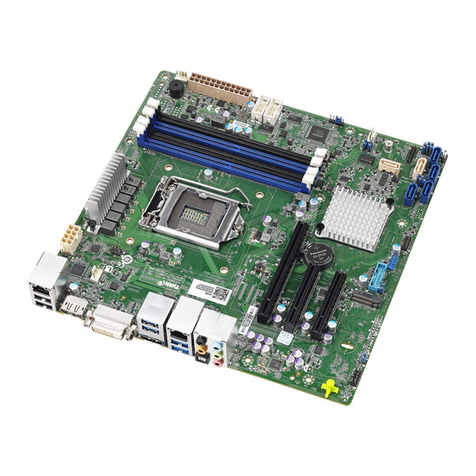
IEI Technology
IEI Technology PCIE-Q370 Quick installation guide

IEI Technology
IEI Technology NOVA-9152 Quick installation guide
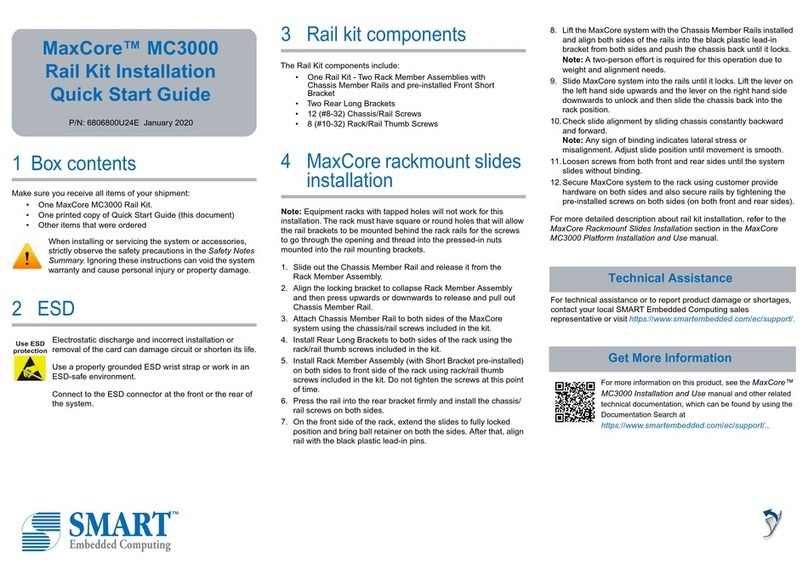
SMART Embedded Computing
SMART Embedded Computing MaxCore MC3000 Installation & quick start guide
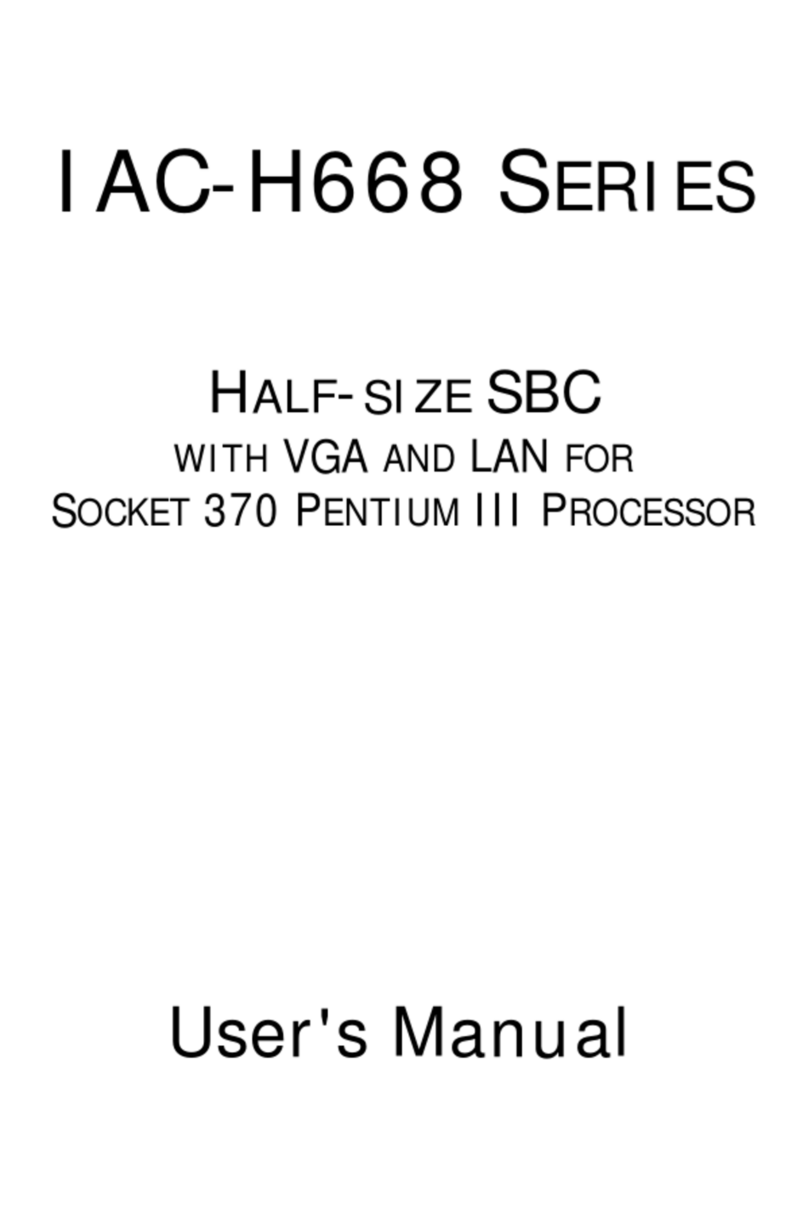
Lanner electronics
Lanner electronics IAC-H668 Series user manual
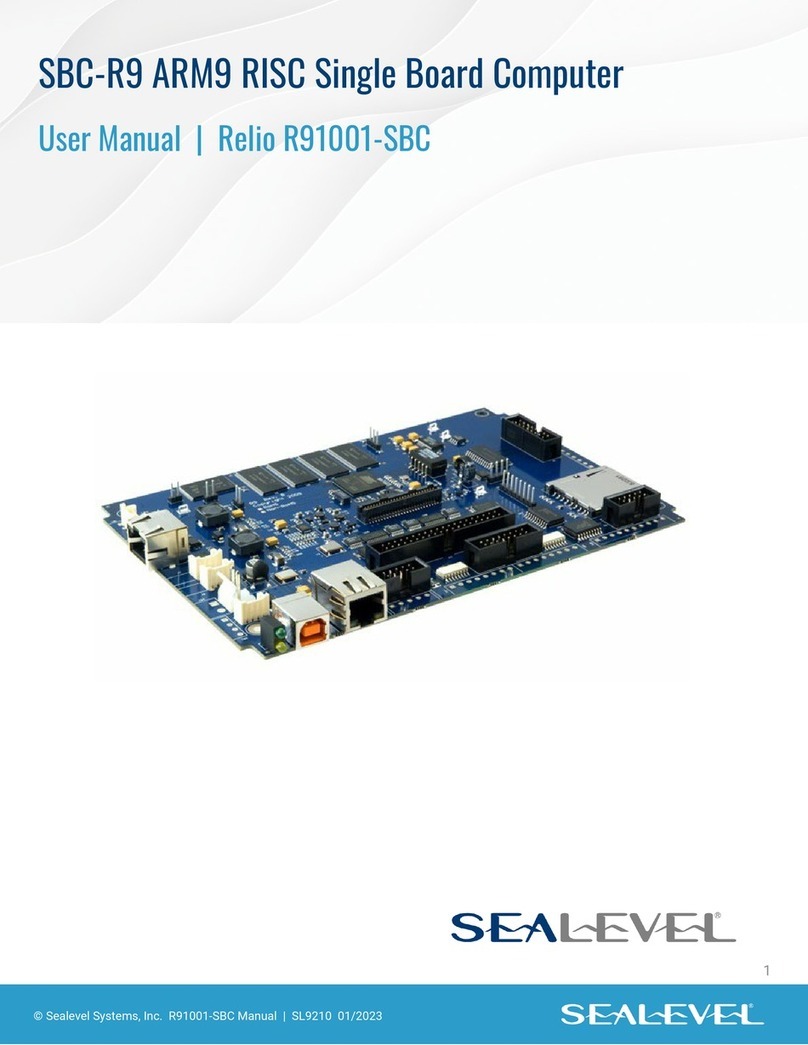
SeaLevel
SeaLevel SBC-R9 user manual
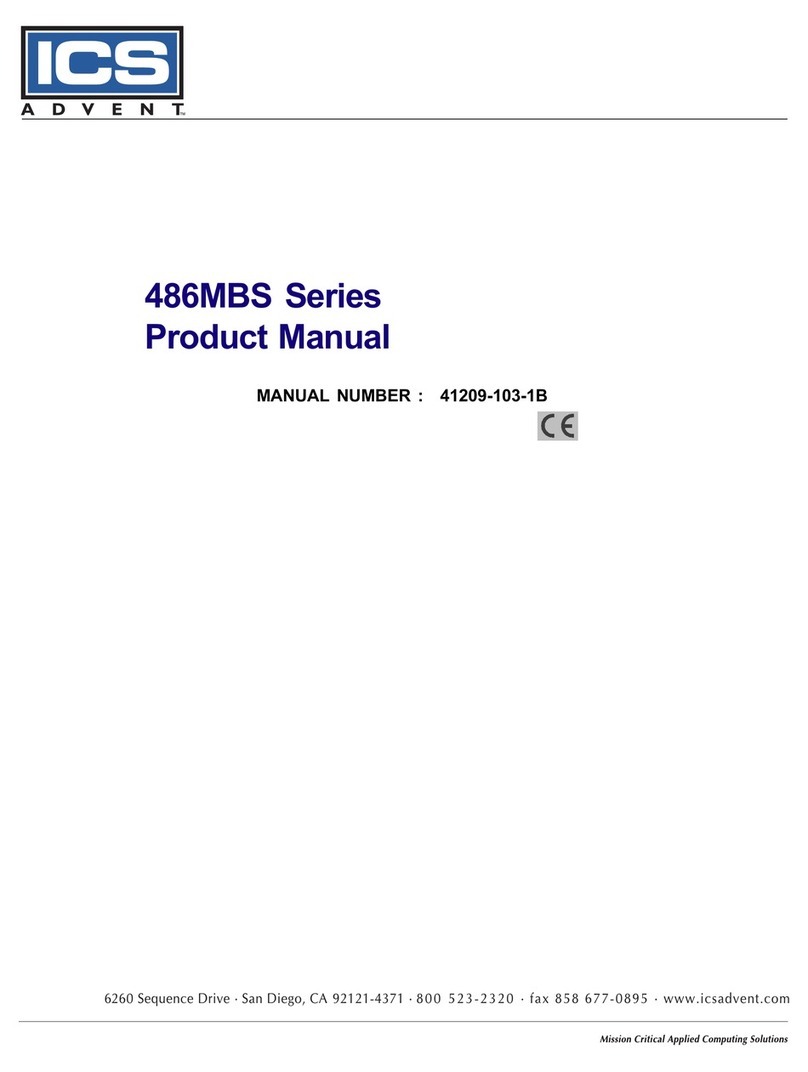
ICS Advent
ICS Advent 486MBS Series product manual

